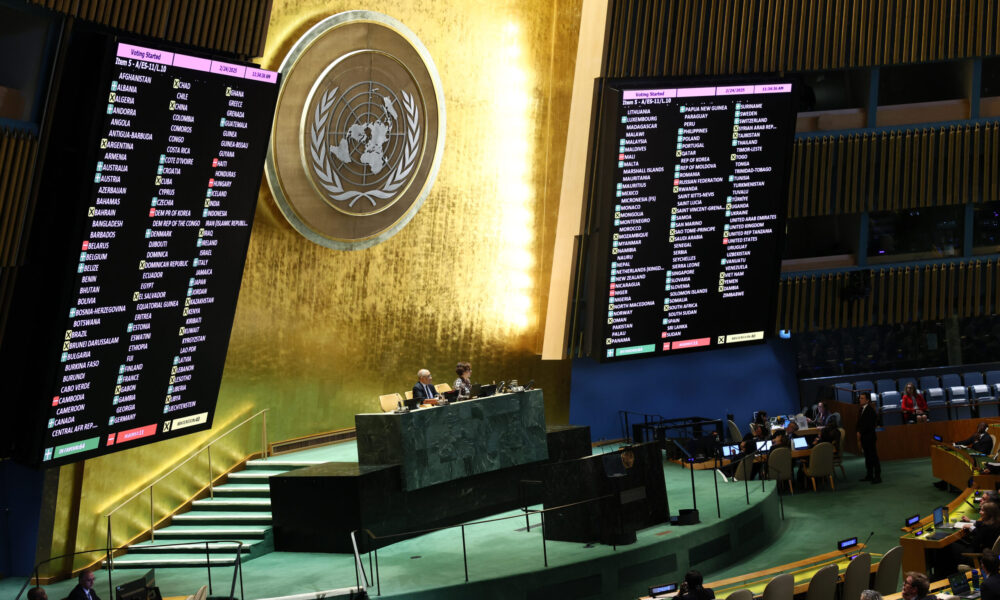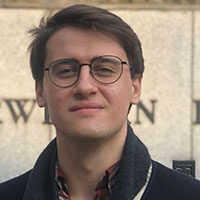While attending the recent Third Meeting of States’ Parties to the Treaty on the Prohibition of Nuclear Weapons (3MSP TPNW) at the United Nations headquarters in New York City, I was struck by the similarities between the movement to ban nuclear weapons and the economic inequality that hampers development around the world. The UN puts great emphasis on the connection between development and peace; UN Secretary-General António Guterres recently declared that “no peace is secure without inclusive and sustainable development that leaves no one behind.” Just as a handful of wealthy countries’ desire to maintain the status quo inhibits global development and furthers inequality, disarmament is obstructed by a few nations with nuclear stockpiles (at the expense of the many).
In both areas, progress has stalled. Poverty alleviation has decelerated and growth in emerging and developing economies has weakened; meanwhile, the global decrease in nuclear warheads has slowed, some states are growing their arsenals, and no nuclear-armed state is taking concrete steps toward disarmament.
At a time when the United States is minimizing its role as a supporter of global development, many UN member states will be seeking alternative development paths, whether by building regional ties or expanding their relationship with countries like China. Likewise, the TPNW is bringing an increasing number of member states together to build and institutionalize pro-disarmament norms.
The way forward is for the global majority—the many nations that have neither nuclear weapons nor the wealth of the United States or the industrial capacity of China—to come together and assert itself as a bloc. Disarmament benefits both nuclear-armed states and non-proliferators, and development benefits both rich and poor countries. In both cases, the majority must collaborate to build an international system that creates alternative paths forward while also putting pressure on the minority.
Who is taking the lead globally?
Like 2023’s Second Meeting of States’ Parties, this year’s meeting served as an important forum for affected communities and nongovernmental organizations. The past year saw the number of signatories to the treaty rise to 94—one shy of a global majority—and states pledged to continue work on the international trust fund meant to compensate communities affected by nuclear testing and use. The working group in charge of the fund will finalize a report on the details of the fund four months before the treaty’s first review conference in December 2026.
I wrote a similar reflection on 2023’s meeting a year and a half ago, where I discussed the persistent reliance on nuclear weapons for security that the TPNW is trying to combat. Since then, the second Trump administration has come into office with a flurry of activity meant to reset the United States’ relationship with its allies, adversaries, and nonaligned third-party states. Whether friend, foe, or something in between, the administration is seeking to end what it sees as foreign “free riding” on US security guarantees, military aid, civilian aid, and more.
This follows years of growing concern within the US government over its decreasing influence, both economically and security-wise, relative to China. During the Biden administration, I listened in on congressional hearings featuring witnesses testifying on China’s work to increase its influence in developing countries (through media campaigns, project financing in the Global South through its Belt and Road Initiative, and a growing presence in, and ties to, Pacific nations). Likewise, on the security side, the Department of Defense sees China as its main challenge going forward, and calls for expanded nuclear capabilities are generally made with China in mind.
Trump’s gutting of the US Agency for International Development (USAID) has been controversial among establishment political and governmental figures. While the administration has charged USAID with being a wasteful funneling of taxpayer money to other countries, former officials, academics, and journalists alike have decried the dismantling of USAID as a strategic blunder. Beyond the crucial and at times life-saving benefits of many of these programs, their proponents argue for the strategic benefits of USAID’s presence in, and support for, global-majority countries.
Many have been quick to tally this as a point lost in the competition with China for global influence. However, US and Chinese development aid are not in competition but mutually complementary; while the United States provides aid almost exclusively in the form of mostly no- or low-cost development assistance, China provides mostly debt financing, usually for infrastructure projects. As one analyst noted, China has “neither the capacity nor the motivation” to fill in gaps left by the United States. Moreover, countries generally do not want to choose one or the other when it comes to aid, development, trade, or political alignment.
Smaller countries have power in numbers
Like development financing and aid, arms control will have to be cooperative to achieve real results. If the future continues to be defined by competition for influence between China and the United States, countries in the global majority have a real opportunity to come together to 1) build stronger institutions and connections instead of depending on bigger countries and 2) coordinate their efforts to ask these countries to do more on arms control. Speaking at the Nobel Peace Prize Forum, Carnegie Endowment for International Peace Senior Fellow Tong Zhao made the point that the TPNW has great potential to serve as a platform for that kind of organized pressure. Developing countries, he said, need to stand up together to oppose nuclear threats or nuclear states’ continued reliance on nuclear weapons for security. The TPNW can help make that possible; at 3MSP, parties to the treaty made a concrete call for the end of nuclear deterrence as a security framework.
Last year, we saw this tension between the global majority and nuclear states in action when the UN General Assembly voted to establish an independent scientific panel to study the physical and societal effects of nuclear war. TPNW states played a key role in making this happen. An updated study is long overdue—the most recent such study is 35 years old. However, the resolution establishing the study did not have universal support. France, Russia, and the United Kingdom—all nuclear weapons states that rely on their arsenal for security—voted against the study. China voted in favor, but every other country possessing nuclear weapons (India, Israel, North Korea, Pakistan, and the United States) abstained.
It seems relatively clear that the nuclear weapons states that voted against the resolution did so because they see such a study as undermining their own ability to threaten nuclear use, and thus their security. In other words, they prefer to enshrine nuclear weapons in their security doctrine over genuinely seeking disarmament. China’s vote for the study is commendable, but despite its desire to maintain a role as a leader of the global majority, it is unlikely to disarm unilaterally. Moreover, despite its policy to not use nuclear weapons first in a conflict and its consistent calls for countries with the largest nuclear arsenals (Russia and the United States) to take the lead on disarmament, China is currently modernizing and increasing the size of its arsenal.
So, as with development in global-majority nations, disarmament is not something one state can do on its own. To reap the collective benefits of nuclear risk reduction and, eventually, full disarmament, states have to work together. The UN is clearly right in tying development to peace, but the global majority has the power to ask the developed world for cooperation on both development assistance and arms control. The Trump administration may claim that it is solely about “America first,” but it is unlikely to abandon its pursuit of influence among developing nations. The global majority will continue to have leverage; it should continue to use it.

